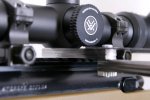Agreed, gravity don't lie, but for this to work, you need to hold the rifle perfectly plumb as well, and what are you using for a reference suface? Most likely the top of the Picatinny rail.
The feeler method only requires that the receiver and rail are properly machined... has nothing to do with the recoil lug assuming that it is not interfering with the stock; if that is the case, that needs to be fixed before continuing.
If the turrets are not square to the flat on the bottom of the turret housing then you've got even bigger problems... your scope is JUNK and needs to be replaced.
If the reticle is canted relative to the turrets then it needs to be fixed, unless you are only going to use holds or turrets for corrections, but not both.
If the reticle is canted and you are always going to use holds then the reticle needs to be plumb; if you're only going to dial corrections then the turrets need to be plumb/square.
Me, I only buy quality scopes with turrets properly indexed to the turret housing and reticles correctly clocked in, and all of the rails I've mounted have been close enough to square that I am unable to measure any deviation, so I use precision gage pins to mount my scopes with the flat on the bottom of the turret housing parallel to within .001" across the flat in the top of the rail.
Joe


